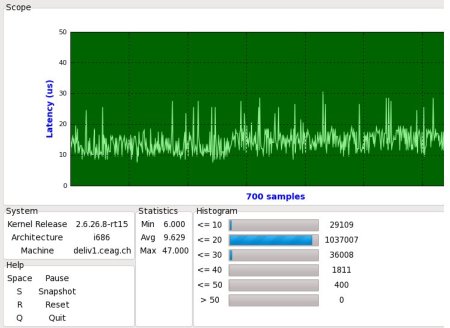Real-time Linux gains accelerated graphics
Feb 11, 2009 — by Eric Brown — from the LinuxDevices Archive — 10 views The Open Source Automation Development Lab (OSADL) announced that the PREEMPT_RT patches have been stabilized with the mainline Linux 2.6.26 kernel. The newly available “latest stable” kernel is said to achieve latency as low as 39 microseconds, while inheriting several interesting new 2.6.26 kernel features.
The Open Source Automation Development Lab (OSADL) announced that the PREEMPT_RT patches have been stabilized with the mainline Linux 2.6.26 kernel. The newly available “latest stable” kernel is said to achieve latency as low as 39 microseconds, while inheriting several interesting new 2.6.26 kernel features.
The PREEMPT_RT patches provide guarantees for hard timing deadlines, as required by many mission critical applications in industries like telecom, military, healthcare, music recording, and financial trading. Sometimes referred to as the “RT Preempt” patch, PREEMPT_RT was originally developed by Ingo Molnar and Thomas Gleixner (pictured below, at right). It represents the upstream version of the real-time patches integrated by MontaVista, Red Hat, Novell, and others into the “real-time” versions of their commercial Linux offerings.
 Thomas Gleixner |
Maintained by the OSADL, PREEMPT_RT is expected to reach the mainline kernel eventually. The patches are fairly extensive, however, and work integrating them with mainline remains ongoing.
The previous “latest stable” release happened last August, and its 2.6.24rt kernel tree will be maintained “for some time” with back-ported features, the OSADL says.
Device trees and cache management
According to the OSADL, the new latest stable kernel includes lots of bug-fixes, including some fixes to the mainline Linux kernel codebase. Naturally, it also benefits from improvements available in the 2.6.26 kernel itself. Of these, two are of special interest are:
- A “flat data structure” device tree, inspired by the Open Firmware project, says the OSADL. The device tree provides information about the devices of a given computer board, thereby facilitating board configuration, and is required to merge PPC and PowerPC architecture implementations. Compiled by the device tree compiler (DTC), the device tree source (DTS) results in a device tree binary (DTB) that is integrated into the boot image, says the group.
- Improved kernel cache management of the video buffer, enabling hardware-accelerated graphics in a real-time system without penalizing real-time capabilities, claims the OSADL. One minor restriction is tolerated here, in that “some latencies in the range of several milliseconds occur once when the graphics board is initialized for the first time,” says the group. However, it is said that subsequent switching to and from graphics, or even restarting the X server, will not produce latencies. In any case, initialization of the graphics board is typically done at boot time before the real-time critical application has launched.
The new version was developed principally by Gleixner and Steven Rostedt, says the OSADL's Carsten Emde, and has been extensively tested. There are “no known problems,” says Emde, and the real-time performance is “superb.” As evidence, he points to Arnaldo Carvalho de Melo's CyclictestoSCOPE testing of the “Latest Stable” on a Core 2 Quad system at 2.4 GHz, using a 32-bit Linux kernel (depicted below).

CyclictestoSCOPE running the “Latest Stable” on a Core 2 Quad system at 2.4 GHz using a 32-bit Linux kernel
(Click to enlarge)
After more than 1 million measurement cycles, the internal worst-case latency was only 47 us, reports Emde. This was despite the fact that the test ran the X Window systen on a hardware-accelerated graphics board, “with heavy use of the entire system including video and audio playback during more than a day,” he adds. Additionally, the system enduring ping floods and other network harassment during the trial.
Emde also reports on a second test running on an Intel Core 2 at 2.4GHz with a 64-bit kernel, which resulted in an internal worst-case latency of 39 us. This is still not in the single-digit latency neighborhood of true hardened real-time operating systems (RTOSes), but it is certainly an impressive showing for a multimedia-enabled Linux environment.
The OSADL recently announced that it had integrated the Real-Time Linux Foundation (RTLF) within its organization. The OSADL, which has recently grown to 26 members, was modeled as an automation-focused version of the OSDL (Open Source Development Labs), which merged with the Free Standards Group (FSG), to form the Linux Foundation.
Availability
The “Latest Stable” release of PREEMPT_RT 2.6.26.8-rt16 is available now. More information may be found here.
This article was originally published on LinuxDevices.com and has been donated to the open source community by QuinStreet Inc. Please visit LinuxToday.com for up-to-date news and articles about Linux and open source.